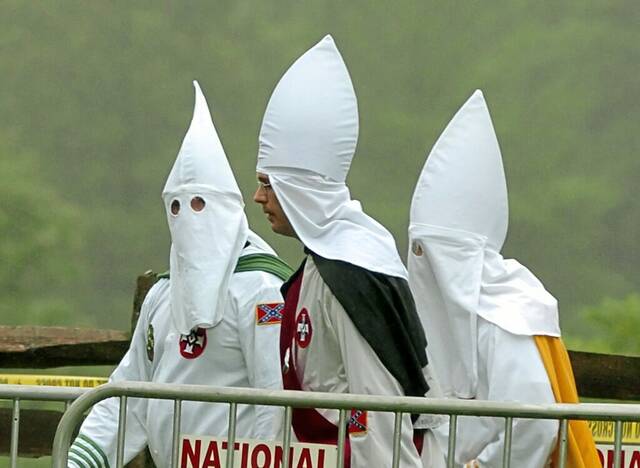https://triblive.com/opinion/paul-kengor-100-years-ago-when-the-kkk-was-dominant-in-western-pa/
Paul Kengor: 100 years ago, when the KKK was dominant in Western Pa.

This summer marks the centenary of the landmark Supreme Court case, Pierce v. Society of Sisters of the Holy Names of Jesus and Mary. The case dealt with a ballot initiative in the state of Oregon that required all parents to send their children to public schools. The actual intended target of the legislation, however, was parochial schools, especially Catholic schools. Advocates hoped the act would effectively eliminate Catholic schools in the state.
Among the act’s fiercest advocates was the Ku Klux Klan, which hoped to see similar legislation nationwide.
Americans today have no idea how strong the Klan was. Its membership nationwide in 1925 approached 6 million (the total U.S. population was 115 million). Members came not only from the South. The KKK was dominant in the Midwest, and in Pennsylvania. According to historian Philip Jenkins, the Klan had an astounding 250,000 members in Pennsylvania.
And it was especially prevalent in our region. According to Jenkins, the Klan “achieved enormous successes” in Western Pennsylvania, with key centers in Pittsburgh, New Kensington, Wilkinsburg and Johnstown. Altoona, says Jenkins, might have had the largest number of Klansmen per capita of any city in America. Allegheny County had 33 so-called klaverns, the most in the state. Westmoreland had the second most (21).
Equally remarkable, many Klan leaders were Protestant pastors, with a special hatred for Catholics. States Jenkins: “Of the traditional targets of the Klan — Blacks, Catholics, and Jews — it was the Catholics who were perceived as the greatest enemy.”
Here, too, the data is shocking. In his book on the Klan in Western Pennsylvania, John Craig writes: “two-thirds of the national Klan lecturers were ministers, and the rolls of the order by 1924 included thirty thousand Protestant clergy.” Craig lists by name several prominent clergy from Allegheny, Blair and Westmoreland counties.
Alarming as this information is, I’m personally not surprised. My family was targeted.
My great-grandfather, Pietro Giovinazzo, came to America from Reggio Calabria in Southern Italy. One day circa 1908, as a stowaway on a ship, unable to receive a passport because he pulled a knife on a policeman during a brawl in the old country, Pietro dove into the Hudson River as the ship approached Ellis Island. Lord knows what he did next. He managed to make his way to the hills of Latrobe.
We don’t know exactly what happened in Latrobe, but Pietro did something bad (if anyone reading this knows anything, please let me know), prompting him and his young family to flee to the mountains of Cameron County, where he changed his name to Pete Grovanz.
They settled in the Rich Valley area outside Emporium, not far from St. Marys, itself a Catholic refuge. They were among the only Catholics. One day at the family farm, surrounded by his wife and little children, he got a visit from the local KKK, led by a pastor who informed Pete: “We’re going to burn you out.”
But Pete was tough as nails. As my Uncle Bruno put it, “He wasn’t afraid of the devil himself.” He fetched two pistols and barked at the Klansmen: “No touch! No touch! I shoot! I shoot!”
The Klan backed down. Ultimately, Pete and Rose Maria built a beautiful life there. Hundreds of us live today because of them.
Unfortunately, what my family of Italian Catholics faced was not unusual. The Klan in this area was brutal — to blacks, Jews and Catholics. It’s a history that more people in these parts should know.
Copyright ©2025— Trib Total Media, LLC (TribLIVE.com)
